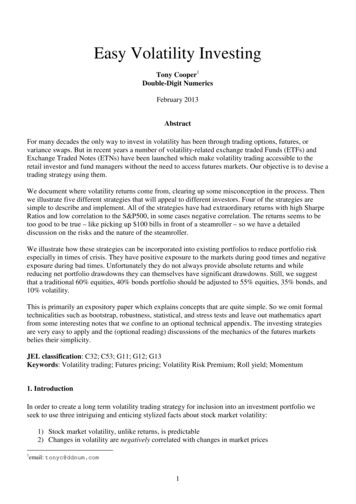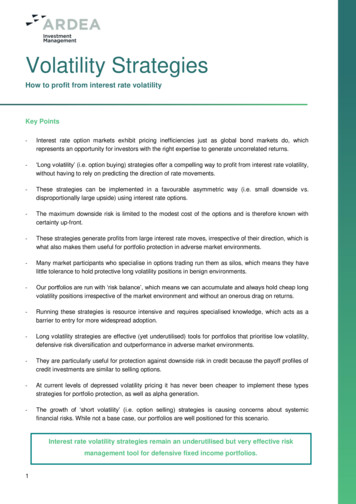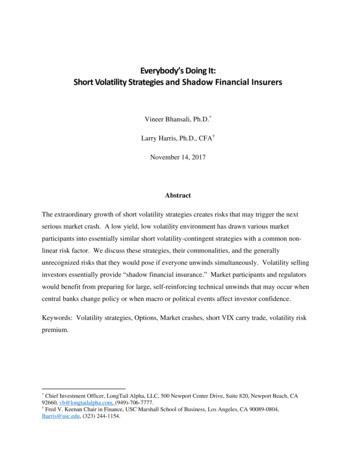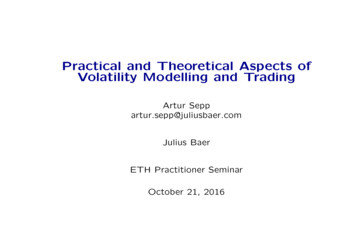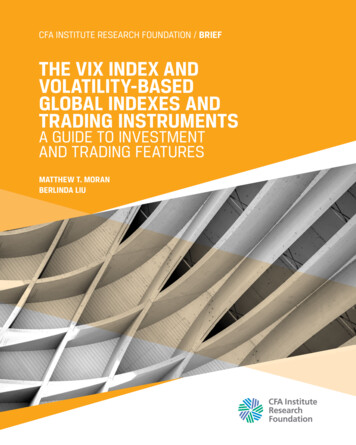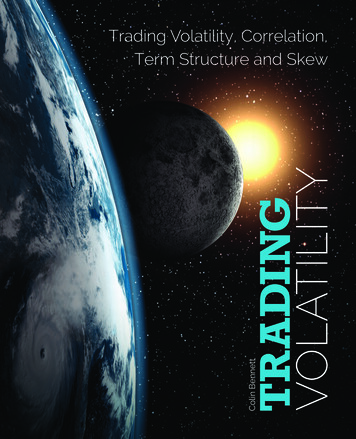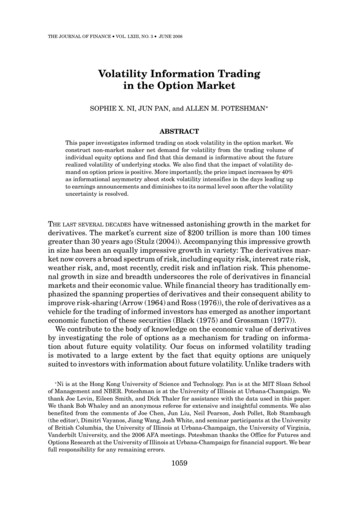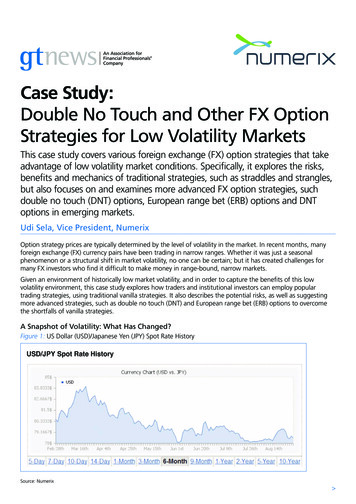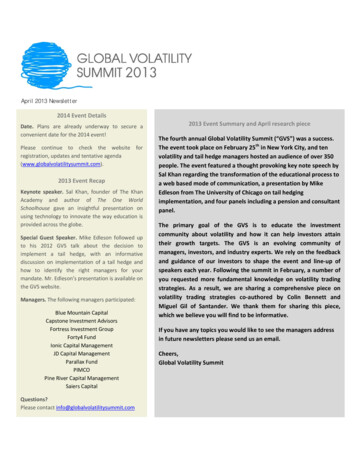
Transcription
April 2013 Newsletter2014 Event DetailsDate. Plans are already underway to secure aconvenient date for the 2014 event!Please continue to check the website forregistration, updates and tentative agenda(www.globalvolatilitysummit.com).2013 Event RecapKeynote speaker. Sal Khan, founder of The KhanAcademy and author of The One WorldSchoolhouse gave an insightful presentation onusing technology to innovate the way education isprovided across the globe.Special Guest Speaker. Mike Edleson followed upto his 2012 GVS talk about the decision toimplement a tail hedge, with an informativediscussion on implementation of a tail hedge andhow to identify the right managers for yourmandate. Mr. Edleson’s presentation is available onthe GVS website.Managers. The following managers participated:Blue Mountain CapitalCapstone Investment AdvisorsFortress Investment GroupForty4 FundIonic Capital ManagementJD Capital ManagementParallax FundPIMCOPine River Capital ManagementSaiers CapitalQuestions?Please contact info@globalvolatilitysummit.com2013 Event Summary and April research pieceThe fourth annual Global Volatility Summit (“GVS”) was a success.The event took place on February 25th in New York City, and tenvolatility and tail hedge managers hosted an audience of over 350people. The event featured a thought provoking key note speech bySal Khan regarding the transformation of the educational process toa web based mode of communication, a presentation by MikeEdleson from The University of Chicago on tail hedgingimplementation, and four panels including a pension and consultantpanel.The primary goal of the GVS is to educate the investmentcommunity about volatility and how it can help investors attaintheir growth targets. The GVS is an evolving community ofmanagers, investors, and industry experts. We rely on the feedbackand guidance of our investors to shape the event and line‐up ofspeakers each year. Following the summit in February, a number ofyou requested more fundamental knowledge on volatility tradingstrategies. As a result, we are sharing a comprehensive piece onvolatility trading strategies co‐authored by Colin Bennett andMiguel Gil of Santander. We thank them for sharing this piece,which we believe you will find to be informative.If you have any topics you would like to see the managers addressin future newsletters please send us an email.Cheers,Global Volatility Summit
Equity DerivativesEuropeMadrid, November 5, 2012VOLATILITY TRADINGTrading Volatility, Correlation, Term Structure and SkewColin BennettMiguel A. GilHead of Derivatives Strategy( 34) 91 289 3056Equity Derivatives Strategy( 34) 91 289 r.comSecond Edition!US investors’ enquiries should be directed to Santander Investment Securities Inc. (SIS) at (212) 692-2550.US recipients should note that this research was produced by a non-member affiliate of SIS and,in accordance with NASD Rule 2711, limited disclosures can be found on the back cover.
CONTENTSWhile there are many different aspects to volatility trading, not all of them are suitable for all investors. Inorder to allow easy navigation, we have combined the sections into seven chapters (plus Appendix) thatare likely to appeal to different parts of the equity derivatives client base. The earlier chapters are mostsuited to equity investors, while later chapters are aimed at hedge funds and proprietary trading desks.Click on section title below to navigatePageEXECUTIVE SUMMARY . 2DIRECTIONAL VOLATILITY TRADING . 11Option trading in practice . 12Maintenance of option positions . 19Call overwriting . 22Protection strategies using options . 28Option structures trading . 34VOLATILITY AND CORRELATION TRADING . 39Volatility trading using options . 40Variance is the key, not volatility . 49Volatility, variance and gamma swaps . 52Options on variance . 65Correlation trading . 69Dividend volatility trading . 83OPPORTUNITIES, IMBALANCES AND MYTHS . 87Overpricing of vol is partly an illusion . 88Long volatility is a poor equity hedge . 90Variable annuity hedging lifts long-term vol . 93Structured products vicious circle . 95FORWARD STARTING PRODUCTS AND VOLATILITY INDICES . 99Forward starting products . 100Volatility indices . 108Futures on volatility indices. 112Volatility future ETN/ETF . 117Option on volatility futures . 122LIGHT EXOTICS . 125Barrier options . 126Worst-of/best-of options . 130Outperformance options . 132Look-back options . 134Contingent premium options . 135Composite and quanto options. 136ADVANCED VOLATILITY TRADING . 139Relative value trading . 140Relative value volatility trading. 145Trading earnings announcements/jumps . 147Stretching Black-Scholes assumptions . 151SKEW AND TERM STRUCTURE TRADING . 159Skew and term structure are linked . 160Square root of time rule can compare different term structures and skews . 166How to measure skew and smile . 171Skew trading . 176APPENDIX . 193Local volatility . 194Measuring historical volatility . 196Proof variance swaps can be hedged by log contract ( 1/K2). 206Proof variance swaps notional vega/2σ . 208Modelling volatility surfaces . 209Black-Scholes formula . 212Greeks and their meaning . 213Advanced (practical or shadow) Greeks. 217Shorting stock by borrowing shares . 220Sortino ratio . 223Capital structure arbitrage . 2241
EXECUTIVE SUMMARYDIRECTIONAL VOLATILITY TRADINGDirectional investors can use options to replace a long position in the underlying, toenhance the yield of a position through call overwriting, or to provide protection fromdeclines. We evaluate these strategies and explain how to choose an appropriate strikeand expiry. We show the difference between delta and the probability that an optionexpires in the money and explain when an investor should convert an option beforematurity. Option trading in practice. Using options to invest has many advantages over investing incash equity. Options provide leverage and an ability to take a view on volatility as well asequity direction. However, investing in options is more complicated than investing inequity, as a strike and expiry need to be chosen. This can be seen as an advantage, as itenforces investor discipline in terms of anticipated return and ensures a position is not heldlonger than it should be. We examine how investors can choose the appropriate strategy,strike and expiry. We also explain the hidden risks, such as dividends, and the differencebetween delta and the probability an option ends up in-the-money. Maintenance of option positions. During the life of an American option, many events canoccur where it might be preferable to own the underlying shares (rather than the option)and exercise early. In addition to dividends, an investor might want the voting rights or,alternatively, might want to sell the option to purchase another option (rolling the option).We investigate these life-cycle events and explain when it is in an investor’s interest toexercise, or roll, an option before expiry. Call overwriting. For a directional investor who owns a stock (or index), call overwritingby selling an OTM call is one of the most popular methods of yield enhancement.Historically, call overwriting has been a profitable strategy due to implied volatility usuallybeing overpriced. However, call overwriting does underperform in volatile, strongly risingequity markets. Overwriting with the shortest maturity is best, and the strike should beslightly OTM for optimum returns. Protection strategies using options. For both economic and regulatory reasons, one of themost popular uses of options is to provide protection against a long position in theunderlying. The cost of buying protection through a put is lowest in calm, low volatilitymarkets but, in more turbulent markets, the cost can be too high. In order to reduce the costof buying protection in volatile markets (which is often when protection is in mostdemand), many investors sell an OTM put and/or an OTM call to lower the cost of the longput protection bought. Option structures trading. While a simple view on both volatility and equity marketdirection can be implemented via a long or short position in a call or put, a far wider set ofpayoffs is possible if two or three different options are used. We investigate strategiesusing option structures (or option combos) that can be used to meet different investorneeds.2
VOLATILITY AND CORRELATION TRADINGWe investigate the benefits and disadvantages of volatility trading via options, volatilityswaps, variance swaps and gamma swaps. We also show how these products, correlationswaps, basket options and covariance swaps can give correlation exposure. Recently,options on alternative underlyings have been created, such as options on variance anddividends. We show how the distribution and skew for these underlyings is different fromthose for equities. Volatility trading using options. While directional investors typically use options for theirequity exposure, volatility investors delta hedge their equity exposure. A delta-hedgedoption (call or put) is not exposed to equity markets, but only to volatility markets. Wedemonstrate how volatility investors are exposed to dividend and borrow cost risk and howvolatility traders can ‘pin’ a stock approaching expiry. We also show that while the profitfrom delta hedging is based on percentage move squared (ie, variance or volatility2), it isthe absolute difference between realised and implied that determines carry. Variance is the key, not volatility. Partly due to its use in Black-Scholes, volatility hashistorically been used as the measure of deviation for financial assets. However, the correctmeasure of deviation is variance (or volatility squared). Volatility should be considered tobe a derivative of variance. The realisation that variance should be used instead ofvolatility-led volatility indices, such as the VIX, to move away from ATM volatility (VXOindex) towards a variance-based calculation. Volatility, variance and gamma swaps. In theory, the profit and loss from delta hedgingan option is fixed and based solely on the difference between the implied volatility of theoption when it was purchased and the realised volatility over the life of the option. Inpractice, with discrete delta hedging and unknown future volatility, this is not the case,which has led to the creation of volatility, variance and gamma swaps. These products alsoremove the need to continuously delta hedge, which can be labour-intensive and expensive. Options on variance. As the liquidity of the variance swap market improved in the middleof the last decade, market participants started to trade options on variance. As volatility ismore volatile at high levels, the skew is positive (the inverse of the negative skew seen inthe equity market). In addition, volatility term structure is inverted, as volatility meanreverts and does not stay elevated for long periods of time. Correlation trading. The volatility of an index is capped at the weighted average volatilityof its constituents. Due to diversification (or less than 100% correlation), the volatility ofindices tends to trade significantly less than its constituents. The flow from bothinstitutions and structured products tends to put upward pressure on implied correlation,making index-implied volatility expensive. Hedge funds and proprietary trading desks tryto profit from this anomaly either by selling correlation swaps or through dispersiontrading (going short index implied and long single stock implied). Basket options andcovariance swaps can also be used to trade correlation. Dividend volatility trading. If a constant dividend yield is assumed, then the volatilitysurface for options on realised dividends should be identical to the volatility surface forequities. However, as companies typically pay out less than 100% of earnings, they havethe ability to reduce the volatility of dividend payments. In addition to lowering thevolatility of dividends to between ½ and⅔ of the volatility of equities, companies arereluctant to cut dividends. This means that skew is more negative than for equities, as anydividend cut is sizeable.3
OPPORTUNITIES, IMBALANCES AND MYTHSThe impact of hedging both structured products and variable annuity products can causeimbalances in the volatility market. These distortions can create opportunities forinvestors willing to take the other side. We examine the opportunities from imbalancesand dispel the myths of overpriced volatility and using volatility as an equity hedge. Overpricing of vol is partly an illusion. Selling implied volatility is one of the mostpopular trading strategies in equity derivatives. Empirical analysis shows that impliedvolatility or variance is, on average, overpriced. However, as volatility is negativelycorrelated to equity returns, a short volatility (or variance) position is implicitly long equityrisk. As equity returns are expected to return an equity risk premium over the risk-free rate(which is used for derivative pricing), this implies short volatility should also beabnormally profitable. Therefore, part of the profits from short volatility strategies can beattributed to the fact equities are expected to deliver returns above the risk-free rate. Long volatility is a poor equity hedge. An ideal hedging instrument for a security is aninstrument with -100% correlation to that security and zero cost. As the return on varianceswaps can have up to a c-70% correlation with equity markets, adding long volatilitypositions (either through variance swaps or futures on volatility indices such as VIX orvStoxx) to an equity position could be thought of as a useful hedge. However, as volatilityis on average overpriced, the cost of this strategy far outweighs any diversification benefit. Variable annuity hedging lifts long term vol. Since the 1980s, a significant amount ofvariable annuity products have been sold, particularly in the US. The size of this market isnow over US 1trn. From the mid-1990s, these products started to become morecomplicated and offered guarantees to the purchaser (similar to being long a put). Thehedging of these products increases the demand for long-dated downside strikes, whichlifts long-dated implied volatility and skew. Structured products vicious circle. The sale of structured products leaves investmentbanks with a short skew position (eg, short an OTM put in order to provide capitalprotected products). Whenever there is a large decline in equities, this short skew positioncauses the investment bank to be short volatility (eg, as the short OTM put becomes moreATM, the vega increases). The covering of this short vega position lifts implied volatilityfurther than would be expected. As investment banks are also short vega convexity, thisincrease in volatility causes the short vega position to increase in size. This can lead to a‘structured products vicious circle’ as the covering of short vega causes the size of theshort position to increase. Similarly, if equity markets rise and implied volatility falls,investment banks become long implied volatility and have to sell. Structured products cantherefore cause implied volatility to undershoot in a recovery, as well as overshoot in acrisis.4
FORWARD STARTING PRODUCTS AND VOLATILITY INDICESForward starting options are a popular method of trading forward volatility and termstructure as there is no exposure to near-term volatility and, hence, zero theta (until thestart of the forward starting option). Recently, trading forward volatility via volatilityfutures such as VIX and vStoxx futures has become increasingly popular. However, as isthe case with forward starting options, there are modelling issues. Forward starting products. As the exposure is to forward volatility rather than volatility,more sophisticated models need to be used to price forward starting products than ordinaryoptions. Forward starting options will usually have wider bid-offer spreads than vanillaoptions, as their pricing and hedging is more complex. Forward starting variance swaps areeasier to price as the price is determined by two variance swaps. Volatility indices. While volatility indices were historically based on ATM implied, mostproviders have swapped to a variance swap based calculation. The price of a volatilityindex will, however, typically be 0.2-0.7pts below the price of a variance swap of the samematurity, as the calculation of the volatility index typically chops the tails to removeilliquid prices. Each volatility index provider has to use a different method of chopping thetails in order to avoid infringing the copyright of other providers. Futures on volatility indices. While futures on volatility indices were first launched on theVIX in March 2004, it has only been since the more recent launch of structured productsand options on volatility futures that liquidity has improved enough to be a viable methodof trading volatility. As a volatility future payout is based on the square root of variance,the payout is linear in volatility not variance. The fair price of a future on a volatility indexis between the forward volatility swap, and the square root of the forward variance swap.Volatility futures are, therefore, short vol of vol, just like volatility swaps. It is thereforepossible to get the implied vol of vol from the listed price of volatility futures. Volatility future ETN/ETF. Structured products based on constant maturity volatilityfutures have become increasingly popular, and in the US have at times had a greater sizethan the underlying volatility futures market. As a constant maturity volatility product needsto sell near-dated expiries and buy far-dated expiries, this flow supports term structure forvolatility futures and the underlying options on the index itself. The success of VIX-basedproducts has led to their size being approximately two-thirds of the vega of the relevant VIXfutures market (which is a similar size to the net listed S&P500 market) and, hence, appearsto be artificially lifting near-dated term structure. The size of vStoxx products is not yetsufficient to significantly impact the market, hence they are a more viable method of tradingvolatility in our view. We recommend shorting VIX-based structured products to profit fromthis imbalance, potentially against long vStoxx-based products as a hedge. Investors whowish to be long VIX futures should consider the front-month and fourth-month maturities,as their values are likely to be depressed from structured flow. Options on volatility futures. The arrival of options on volatility futures has encouragedtrading on the underlying futures. It is important to note that an option on a volatility futureis an option on future implied volatility, whereas an option on a variance swap is an optionon realised volatility. As implieds always trade at a lower level to peak realised (as younever know when peak realised will occur) the volatility of implied is lower than thevolatility of realised, hence options on volatility futures should trade at a lower impliedthan options on var. Both have significantly downward sloping term structure and positiveskew. We note that the implied for options on volatility futures should not be compared tothe realised of volatility indices.5
LIGHT EXOTICSAdvanced investors can make use of more exotic equity derivatives. Some of the mostpopular are light exotics, such as barriers, worst-of/best-of options, outperformanceoptions, look-back options, contingent premium options, composite options and quantooptions. Barrier options. Barrier options are the most popular type of light exotic product as theyare used within structured products or to provide cheap protection. The payout of a barrieroption knocks in or out depending on whether a barrier is hit. There are eight types ofbarrier option, but only four are commonly traded, as the remaining four have a similarprice to vanilla options. Barrier puts are more popular than calls (due to structured productand protection flow), and investors like to sell visually expensive knock-in options and buyvisually cheap knock-out options. Worst-of/best-of options. Worst-of (or best-of) options give payouts based on the worst(or best) performing asset. They are the second most popular light exotic due to structuredproduct flow. Correlation is a key factor in pricing these options, and investor flowtypically buys correlation (making uncorrelated assets with low correlation the mostpopular underlyings). The underlyings can be chosen from different asset classes (due tolow correlation), and the number of underlyings is typically between three and 20. Outperformance options. Outperformance options are an option on the differencebetween returns on two different underlyings. They are a popular method of implementingrelative value trades, as their cost is usually cheaper than an option on either underlying.The key unknown parameter for pricing outperformance options is implied correlation, asoutperformance options are short correlation. Look-back options. There are two types of look-back options, strike look-back and payoutlook-back, and both are usually multi-year options. Strike reset (or look-back) options havetheir strike set to the highest, or lowest, value within an initial look-back period (of up tothree months). These options are normally structured so the strike moves against theinvestor in order to cheapen the cost. Conversely, payout look-back options tend to bemore attractive and expensive than vanilla options, as the value for the underlying used isthe best historical value. Contingent premium options. Contingent premium options are initially zero-premiumand only require a premium to be paid if the option becomes ATM on the close. Thecontingent premium to be paid is, however, larger than the initial premium would be,compensating for the fact that it might never have to be paid. Puts are the most popular,giving protection with zero initial premium. Composite and quanto options. There are two types of options involving differentcurrencies. The simplest is a composite option, where the strike (or payoff) currency is in adifferent currency than the underlying. A slightly more comp
an option is fixed and based solely on the difference between the implied volatility of the option when it was purchased and the realised volatility over the life of the option. In practice, with discrete delta hedging and unknown future volatility, this is not the case, which has led
